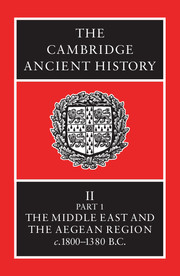Book contents
- Frontmatter
- Contents
- List of Maps
- List of Tables
- List of Text-figures
- Preface
- CHAPTER I NORTHERN MESOPOTAMIA AND SYRIA
- CHAPTER II EGYPT: FROM THE DEATH OF AMMENEMES III TO SEQENENRE II
- CHAPTER III PALESTINE IN THE MIDDLE BRONZE AGE
- CHAPTER IV
- (a) GREECE AND THE AEGEAN ISLANDS IN THE MIDDLE BRONZE AGE
- (b) THE MATURITY OF MINOAN CIVILIZATION
- (c) CYPRUS IN THE MIDDLE BRONZE AGE
- CHAPTER V HAMMURABI AND THE END OF HIS DYNASTY
- CHAPTER VI ANATOLIA c. 1750–1600 B.C.
- CHAPTER VII PERSIA c. 1800–1550 B.C.
- CHAPTER VIII EGYPT: FROM THE EXPULSION OF THE HYKSOS TO AMENOPHIS I
- CHAPTER IX EGYPT: INTERNAL AFFAIRS FROM TUTHMOSIS I TO THE DEATH OF AMENOPHIS III
- CHAPTER X SYRIA c. 1550–1400 B.C.
- CHAPTER XI PALESTINE IN THE TIME OF THE EIGHTEENTH DYNASTY
- CHAPTER XII THE ZENITH OF MINOAN CIVILIZATION
- CHAPTER XIII THE LINEAR SCRIPTS AND THE TABLETS AS HISTORICAL DOCUMENTS
- CHAPTER XIV THE RISE OF MYCENAEAN CIVILIZATION
- CHAPTER XV ANATOLIA c. 1600–1380 b.c.
- CHAPTER XVI THE ARCHAEOLOGICAL EVIDENCE OF THE SECOND MILLENNIUM B.C. ON THE PERSIAN PLATEAU
- BIBLIOGRAPHIES
- Chronological Tables
- Index to Maps
- General Index
- Map 1: Greece and the Aegean Islands in the Middle Bronze Age.
- Map 3: Babylonia and Western Persia.
- Fig. 7. Plan of the Palace at Cnossus.
- Map 6: Ancient Asia Minor and Northern mesopotamia
- References
(b) - THE MATURITY OF MINOAN CIVILIZATION
from CHAPTER IV
Published online by Cambridge University Press: 28 March 2008
- Frontmatter
- Contents
- List of Maps
- List of Tables
- List of Text-figures
- Preface
- CHAPTER I NORTHERN MESOPOTAMIA AND SYRIA
- CHAPTER II EGYPT: FROM THE DEATH OF AMMENEMES III TO SEQENENRE II
- CHAPTER III PALESTINE IN THE MIDDLE BRONZE AGE
- CHAPTER IV
- (a) GREECE AND THE AEGEAN ISLANDS IN THE MIDDLE BRONZE AGE
- (b) THE MATURITY OF MINOAN CIVILIZATION
- (c) CYPRUS IN THE MIDDLE BRONZE AGE
- CHAPTER V HAMMURABI AND THE END OF HIS DYNASTY
- CHAPTER VI ANATOLIA c. 1750–1600 B.C.
- CHAPTER VII PERSIA c. 1800–1550 B.C.
- CHAPTER VIII EGYPT: FROM THE EXPULSION OF THE HYKSOS TO AMENOPHIS I
- CHAPTER IX EGYPT: INTERNAL AFFAIRS FROM TUTHMOSIS I TO THE DEATH OF AMENOPHIS III
- CHAPTER X SYRIA c. 1550–1400 B.C.
- CHAPTER XI PALESTINE IN THE TIME OF THE EIGHTEENTH DYNASTY
- CHAPTER XII THE ZENITH OF MINOAN CIVILIZATION
- CHAPTER XIII THE LINEAR SCRIPTS AND THE TABLETS AS HISTORICAL DOCUMENTS
- CHAPTER XIV THE RISE OF MYCENAEAN CIVILIZATION
- CHAPTER XV ANATOLIA c. 1600–1380 b.c.
- CHAPTER XVI THE ARCHAEOLOGICAL EVIDENCE OF THE SECOND MILLENNIUM B.C. ON THE PERSIAN PLATEAU
- BIBLIOGRAPHIES
- Chronological Tables
- Index to Maps
- General Index
- Map 1: Greece and the Aegean Islands in the Middle Bronze Age.
- Map 3: Babylonia and Western Persia.
- Fig. 7. Plan of the Palace at Cnossus.
- Map 6: Ancient Asia Minor and Northern mesopotamia
- References
Summary
THE CHRONOLOGY OF THE EARLY PALACE PERIOD (c. 2000–1700 b.c.)
The first palaces in Crete were built soon after the turn of the millennium. Could there be a more obvious mark than this for the beginning of an epoch? With them Minoan civilization rose from its prehistoric beginnings and attained the rank of an advanced civilization. But did it really even now enter the realm of history? Names, personalities and direct written sources are lacking. On the other hand the historical setting of this civilization cannot be disputed. It finds expression in its involvement in contemporary and subsequent events of Mediterranean history. Monuments consequently play a greater part than actions and people in providing a picture of this period, and the archaeological interpretation of these monuments is of cardinal importance. The Greeks later associated this period with the figure of Minos in their mythology. Any attempt to separate the historical and the mythical features of Minos is hopeless, but his name has rightly been given to this civilization which we can discern in the strange light of early history.
The palaces stood for about 600 years. After their destruction in about 1400 b.c. they were not rebuilt. The Palace Period can be split into an earlier and a later stage in terms of stratification and architectural developments. The present chapter is concerned only with the earlier stage of the Palace Period.
- Type
- Chapter
- Information
- The Cambridge Ancient History , pp. 141 - 164Publisher: Cambridge University PressPrint publication year: 1973



